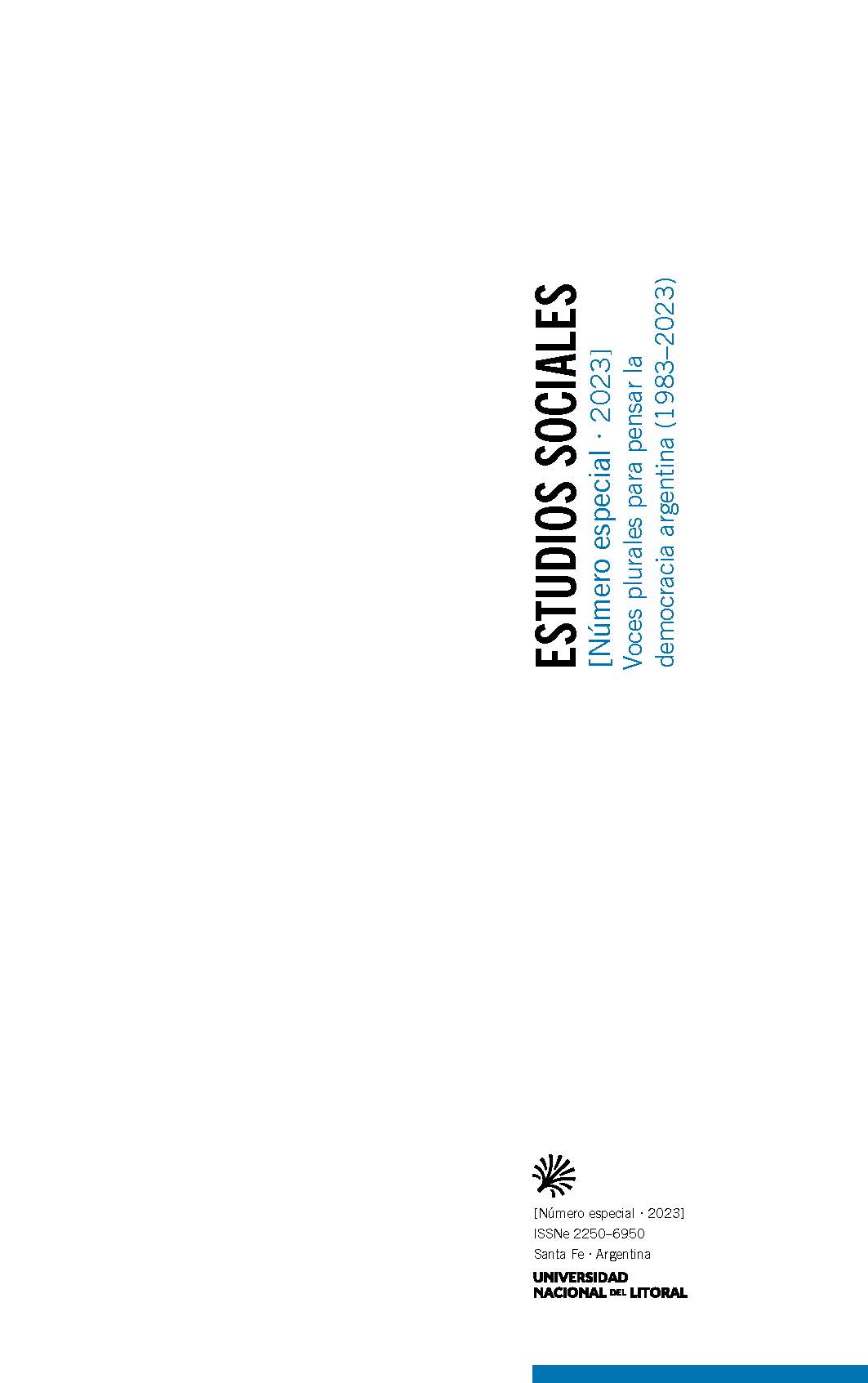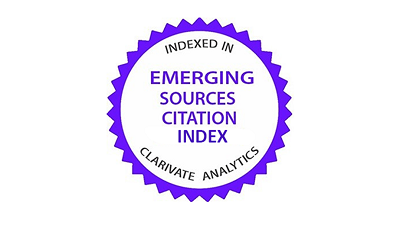Aportes teórico- metodológicos para un estudio complejo de la representación política de las mujeres
DOI:
https://doi.org/10.14409/es.v57i2.7269Palabras clave:
Representación política de las mujeres, Teoría de la masa crítica, Declaraciones representativas, Dimensión simbólicaResumen
Los estudios que analizan la representación política de las mujeres han utilizado las afirmaciones de la teoría de la masa crítica como marco metodológico para el análisis empírico. La principal tesis de esta teoría es que una mayor representación descriptiva de las mujeres representantes provoca un cambio de política en favor de los intereses y los derechos de las mujeres. No obstante, recientemente han surgido nuevos posicionamientos teóricos que se presentan como antagónicos a la teoría de la masa crítica. Estas perspectivas prestan mayor atención principalmente a las dimensiones sustantivas y simbólicas al proponer un análisis enfocado en cómo se construyen discursivamente. Si bien este paradigma se presenta cómo opuesto al de la masa crítica, en el presente artículo, sostendremos que es necesario producir una articulación entre ellos para entender en toda su complejidad la representación política de las mujeres.
Citas
ALEXANDER, AMY C. (2012): «Change in Women's Descriptive Representation and the Belief in Women's Ability to Govern: A Virtuous Cycle», en: Politics & Gender, nº 8, pp. 437-464.
ARCHENTI, NÉLIDA (2014): «El proceso hacia la paridad en América Latina. Argentina y Costa Rica», en: Revista Derecho Electoral, nº º 17, pp. 304-332.
ARCHENTI, NÉLIDA, TULA, MARÍA INÉS (2008): «Algunas cuestiones iniciales sobre las leyes de cuotas», en: N. Archenti y M. I. Tula (eds.), Mujeres y política en América Latina. Sistemas electorales y cuotas de género, Buenos
Aires, Heliasta.
ARCHENTI, NÉLIDA, TULA, MARÍA INÉS (coord.) (2014): La representación imperfecta. Logros y desafíos de las mujeres políticas, Buenos Aires, Eudeba.
ATKESON, LONNA RAE (2003): Not All Cues Are Created Equal: The Conditional Impact of Female Candidates on Political Engagement, en: The Journal of Politics, vol. 65, nº 4, pp. 1040–1061.
ATKESON, LONNA RAE, CARRILLO, NANCY (2007): «More is Better: The Influence of Collective Female Descriptive Representation on External Efficacy», en: Politics & Gender, nº 3, pp. 79–101.
BANASZAK, LEE ANN, BECKWITH KAREN, RUCHT DIETER (2003): «When power relocates: Interactive changes in women’s movements and states», en: L. A. Banaszak, K. Beckwith and D. Rucht (ed.), Women’s Movements Facing the Reconfigured State, Cambridge, Cambridge University Press, pp. 1–29.
BARNES, TIFFANY (2013): «Gender and Legislative Preferences: Evidence from the Argentine Provinces», en: Politics & Gender, vol. 8, nº 4, pp. 483-507.
BARNES, TIFFANY (2014): «Women’s representation and legislative committee appointments: the case of the argentine Provinces», en: Revista Uruguaya de Ciencia Política, vol. 23, nº 2, pp. 135-161.
BECKWITH, KAREN, COWELL-MEYERS, KIMBERLY (2007): «Sheer numbers: Critical representation thresholds and women’s political representation», en: Perspectives on Politics, vol. 5, nº 3, pp. 553–565.
BORNER JUTTA, CAMINOTTI, MARIANA, MARX, JUTTA, RODRÍGUEZ GUSTÁ ANA LAURA (2009): Ideas, presencias y jerarquías políticas. Claro oscuros de la igualdad de género en el Congreso Nacional de Argentina, Buenos Aires, Prometeo.
BUTLER, JUDITH (1998): «Actos performativos y constitución del género: un ensayo sobre fenomenología y teoría feminista», en: Debate Feminista, nº 18, pp. 296-314.
BUTLER, JUDITH (1999): Gender Touble. Feminism and the subversion of Identity, New York, Routlegde.
BURNS, NANCY, LEHMAN SCHLOZMAN,KAY, VERBA, SIDNEY (2001): The Private Roots of Public Action: Gender, Equality and Political Participation, Cambridge, Harvard University Press.
CALVO, ERNESTO (2014): Legislator success in fragmented congresses in Argentina: Plurality cartels, minority presidents, and lawmaking, Cambridge, Cambridge University Press.
CAMINOTTI, MARIANA (2017): La paridad política en Argentina: avances y desafíos, Buenos Aires/Lima/Panamá, Programa Naciones Unidas para el Desarrollo-PNUD/IDEA Internacional/Organización de las Naciones Unidas. Mujeres. Disponible en: http://www.ar.undp.org/content/argentina/es/home/library/womens_empowerment/IPPArgentinaLibro/ (último ingreso: 14/02/2018).
CARROLL SUSAN J. (ed.) (1995): Impact of Women in Public Office, New Brunswick, Rutgers University Press.
CELIS, KAREN (2006): «Substantive representation of women and the impact of descriptive representation. Case: The Belgian Lower House 1900–1979», en: Journal of Women, Politics and Policy, vol. 28, nº 2, pp. 85–114.
CELIS, KAREN (2008): «Studying women's substantive representation in legislatures: when representative acts, contexts and women's interests become important», en: Representation, vol. 44, nº 2, pp. 111-123.
CELIS, KAREN (2009): «Substantive representation of women (and improving it): What it is and should be about?», en: Comparative European Politics, nº 7, pp. 95–113.
CELIS, KAREN,CHILDS, SARAH, KANTOLA, JHOANA, KROOK, MONA LENA (2008): «Rethinking Women's Substantive Representation», en: Representation, vol. 44, nº 2, pp. 99-110.
CELIS, KAREN,CHILDS, SARAH, KANTOLA, JHOANA, KROOK, MONA LENA (2014): «Constituting Women’s Interests through Representative Claims», en: Politics & Gender, nº 10, pp. 149–174.
CHAPPELL, LOUISE (2002): «The femocrat strategy: Expanding the repertoire of feminist activists», en: ROSS, Karen (ed.), Women, Politics and Change, Oxford, Oxford University Press, pp. 85–98.
DAHLERUP, DRUDE (1988): «From a Small to a Large Minority: Women in Scandinavian Politics», en: Scandinavian Political Studies, vol. II, nº 4, pp. 275-298.
DAHLERUP, DRUDE (2006): «The Story of the Theory of Critical Mass», en: Politics & Gender, nº 2, pp. 511-522.
DESPOSATO, SCOTT, NORRANDER, BARBARA (2009): «The Gender Gap in Latin America: Contextual and Individual Influences on Gender and Political Participation», en: British Journal of Political Science, vol. 39, nº 1, pp. 141 – 162.
DODSON, DEBRA (2006): The Impact of Women in Congress, New York, Oxford University Press.
FRANCESCHET, SUSAN, PISCOPO JENNIFER (2008): «Gender Quotas and Women’s Substantive Representation: Lessons from Argentina», en: Politics & Gender, nº 4, pp. 393–425.
GREY, SANDRA (2006): «Numbers and beyond: The relevance of critical mass in gender research», en: Politics & Gender, nº 2, pp. 491-530.
HTUN, MALA, JONES, MARK P. (2002): «Engendering the Right to Participate in Decision-Making», en: M. Craske y M. Molyneux (eds.), Gender and the Politics of Rights and Democracy in Latin America, Basingstoke, Palgrave.
JAQUETTE, JANE S. (1997): «Women in Power: From Tokenism to Critical Mass», en: Foreign Policy, nº 108, pp. 23-37.
KANTER, ROSABETH MOSS (1977): «Some Effects of Proportions on Group Life: Skewed Sex Ratios and Responses to Token Women», en: American Journal of Sociology, vol. 82, nº 5, pp. 965-990.
KANTOLA, JOHANNA (2006): Feminists Theorize the State, Basingstoke, Palgrave Macmillan.
KANTOLA, JOHANNA, OUTSHOORN, JOYCE (2007): «Changing state feminism», en: OUTSHOORN, KANTOLA (ed.) Changing State Feminism, Basingstoke, Palgrave Macmillan, pp. 1–19.
KARP, JEFFREY A., BANDUCCI, SUSAN (2008): «When politics is not just a man’s game: Women’s representation and political engagement», en: Electoral Studies, nº 27, pp. 105-115.
KATHLENE, LYN (1994): «Power and influence in State Legislative Policymaking: The interaction of gender and position in committee hearing debates», en: American Political Science Review, vol. 88, nº 3, pp. 560-576.
KITTILSON, MIKI CAUL (2005): «In Support of Gender Quotas: Setting New Standards, Bringing Visible Gains», en: Politics & Gender, vol. 1, nº 4, pp. 638-645.
LAWLESS, JENNIFER L. (2004): «Politics of Presence? Congresswomen and Symbolic Representation Political», en: Research Quarterly, vol. 57, nº 1, pp. 81-99.
LOMBARDO, EMANUELA, MEIER, PETRA (2014): The Symbolic Representation of Gender: a discursive approach, Surrey and Burlington, Ashgate.
LOMBARDO, EMANUELA, MEIER, PETRA (2017): «Capturing in words what a symbol symbolizes? Challenges for studying symbolic representation from a discursive approach», en: Politics, Groups, and Identities, vol. 5, nº 3, 482-487.
LOVENDUSKI, JONI (ed.) (2005): State Feminism and Political Representation, Cambridge/New York, Cambridge University Press.
MACKAY, FIONA (2008): «‹Thick› Conceptions of substantive representation: women, gender and political institutions», en: Representation, vol. 44, nº 2, pp. 125-139.
MARX, JUTTA, CAMINOTTI, MARIANA, BORNER, JUTTA (2007): Las legisladoras. Cupos de género y política en Argentina y Brasil, Buenos Aires, Siglo XXI.
NORRIS, PIPPA (1996): «Women Politicians: Transforming Westminster?», en: Parliamentary Affairs, vol. 49, nº 1, pp. 89-102.
PÉREZ, VERÓNICA (2014): «Asignación partidaria y especialización: las legisladoras en el sistema de Comisiones de la Cámara de Diputados de Argentina», en: Revista Uruguaya de Ciencia Política, vol. 23, nº 2, pp. 165-184.
PITKIN, HANNA (1967): The concept of representation, Berkeley, University of California Prees.
PIATTI-CROCKER, ADRIANA (2014): «Dos décadas de cuotas de género en Argentina: difusión de políticas y sus efectos», en: N. Archenti y M. I. Tula (comp.), La representación imperfecta. Logros y desafíos de las mujeres políticas, Buenos Aires, Eudeba, pp. 105-128.
RODRÍGUEZ GUSTÁ, ANA LAURA, MADERA, NANCY (2014): «Dimensiones colectivas, relacionales y supranacionales en la construcción de una agenda legislativa de Derechos Humanos de mujeres en América Latina», en: Revista Uruguaya de Ciencias Políticas, vol. 23, pp. 37-64.
SACCHET, TERESA (2008): «Beyond Numbers. The impact of Gender Quotas in Latin America», en: International Feminist Journal of Politics, vol. 10, nº 3, pp. 369-386.
SAWARD, MICHAEL (2010): The representative claim, New York, Oxford University Press.
SAWARD, MICHAEL (2012): «Claims and constructions», en: Contemporary Political Theory, vol. 11, nº 1, pp. 123-127.
SCHWINDT-BAYER, LESLIE A, MISHLER, WILLIAM (2005): «An Integrated Model of Women’s Representation», en: The Journal of Politics, vol. 67, nº 2, pp. 407-428.
STAUDT, KATHLEEN (1996): «Women in politics: Mexico in global perspective», en: RODRIGUEZV. E. (ed.), Women’s participation in Mexican political life, Boulder, Westview Press.
STOFFEL, SOPHIE (2008): «Rethinking political representation: the case of institutionalized feminist organizations in Chile», en: Representation, vol. 44, nº 2, pp. 141-154.
STUDLAR, DONLEY T., MCALLISTER, IAN (2002): «Electoral systems and women's representation: a long‐term perspective», en: Representation, vol. 39, nº 1, pp. 3-14.
THOMAS, SUE (1991): «The Impact of Women on State Legislative Policies», en: The Journal of Politics, vol. 53, nº 4, pp. 958-976.
THOMAS, SUE (1994): How Women Legislate, New York, Oxford University Press.
WELDON, LAUREN (2002): «Beyond Bodies: Institutional Sources of Representation for Women in Democratic Policymaking», en: The Journal of Politics, vol. 64, nº 4, pp. 1153-1174.
WOLBRECHT, CHRISTINA AND CAMPBELL DAVID E. (2007): «Leading by Example: Female Members of Parliament as Political Role Models», en: American Journal of Political Science, vol. 51, nº 4, October, pp. 921–939.
YODER, JANICE D. (1991): «Rethinking Tokenism. Looking Beyond Numbers», en: Gender & Society, vol. 5, nº 2, pp 178-192.
ZETTERBERG, PÄR (2009): «Do Gender Quotas Foster Women’s Political Engagement? Lessons from Latin America», en: Political Research Quarterly, vol. 62, nº 4, pp. 715-730.
Descargas
Publicado
Cómo citar
Número
Sección
Licencia
Los artículos publicados en Estudios Sociales. Revista Universitaria Semestral se encuentran disponibles gratuitamente en la Biblioteca Virtual de Publicaciones Periódicas de la Universidad Nacional del Litoral: http://bibliotecavirtual.unl.edu.ar/publicaciones.
El contenido está bajo Licencia Creative Commons Atribución-NoComercial-Compartir Igual 4.0 Internacional (BY-NC-SA): no se permite un uso comercial de la obra original ni de las posibles obras derivadas, la distribución de las cuales se debe hacer con una licencia igual a la que regula la obra original.
 Los artículos que sean aceptados, deberán ser acompañados del documento "Autorización para Publicar" que contiene la firma de los autores, en donde se acepta la originalidad del documento y autorizan a la Revista a la publicación del mismo. Las opiniones vertidas por los autores en sus artículos no reflejan necesariamente el parecer de Estudios Sociales. Revista Universitaria Semestral. El contenido de cada trabajo es responsabilidad exclusiva de su autor. En caso de que se utilicen trabajos, datos y/o palabras de otros autores, éstos tienen que ser debidamente citados. Cualquier contenido que sea detectado como fraudulento será elevado al Consejo Editorial de la revista para su revisión, quienes evaluarán el caso y determinarán los pasos a seguir.
Los artículos que sean aceptados, deberán ser acompañados del documento "Autorización para Publicar" que contiene la firma de los autores, en donde se acepta la originalidad del documento y autorizan a la Revista a la publicación del mismo. Las opiniones vertidas por los autores en sus artículos no reflejan necesariamente el parecer de Estudios Sociales. Revista Universitaria Semestral. El contenido de cada trabajo es responsabilidad exclusiva de su autor. En caso de que se utilicen trabajos, datos y/o palabras de otros autores, éstos tienen que ser debidamente citados. Cualquier contenido que sea detectado como fraudulento será elevado al Consejo Editorial de la revista para su revisión, quienes evaluarán el caso y determinarán los pasos a seguir.
Estudios Sociales. Revista Universitaria Semestral adhiere al Código de Conducta y Guía de Buenas Prácticas para editores científicos del Comité de Ética de Publicaciones (COPE):http://publicationethics.org/















